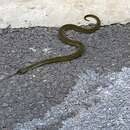pt-BR
nomes no trilho de navegação


When angered, C. lichtensteini responds by inflating the body with air, and hissing and puffing. It may then raise the forepart of the body off the ground, into a coil with the head back, and strike (Spawls et al., 2002).
Forest night adder
These snakes reach a maximum size of about 70 cm, the average size is between 30 to 55 cm. The dorsal pattern consists of green scales, which can vary between individuals from pale green to dark or olive green, and sometimes brown. Some individuals have two or three orange bars across the tail. There is sometimes a series of vague, pale-centered rhombic back markings, which may be obscured and appear as chevrons, facing forwards or backwards. The ventral scales can be yellowish, cream or pearly. The labial scales are yellow and the tongue is black with an orange band. Juveniles have a distinct white V-shape marking on the neck; this fades as they mature into a very fine V-shape, sometimes with black edging (Spawls, et al., 2002).
There are 15 scale rows at midbody, 134 to 156 ventral scales, and 14 to 23 subcaudal scales (Spawls et al., 2002).
C. lichtensteini is known to consume frogs and toads (Ineich et al., 2006).
Guinea and Liberia eastward through Ghana to Nigeria, Cameroon, Equatorial Guinea, Central African Republic, south to northern Angola, Zaire, and north-western Zambia and east to Uganda and western Kenya (McDiarmid et al., 1999).
C. lichtensteini is active mostly during the day among the shade and leaf litter of the forest floor. They swim well and have colonized islands in Lake Victoria. When inactive, they hide in holes, brush piles, tree root clusters, under ground cover and other similar nooks (Spawls et al., 2002).
Forest and woodland, swampy areas associated with forest and recently deforested areas, from 500 to 2100 m elevation.
C. lichtensteini's green colour and white V-mark on the neck make it unmistakable (Spawls et al., 2002).
Type specimen lost according to Golay et al. (1993).
Type locality: "Costa d'oro" [Gold Coast, Ghana]